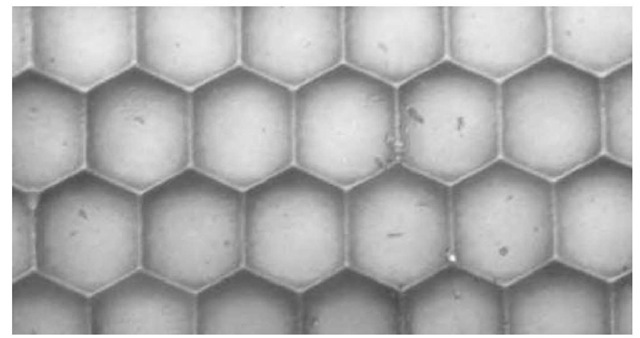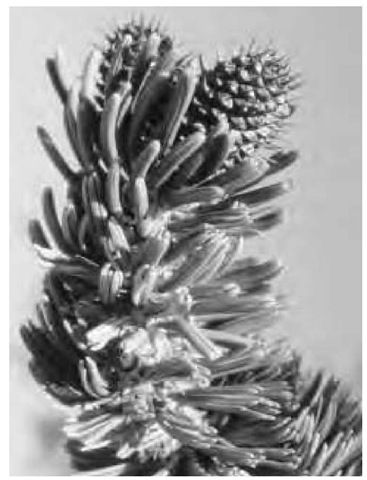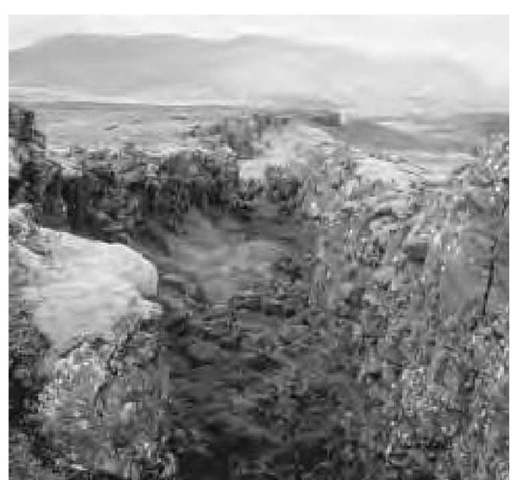Comproportionation Describes a chemical reaction when a mixture of species in different oxidation states reacts to produce a product that is in a different but more stable intermediate oxidation state. A type of redox reaction. For example, when iodide ions and iodate ions react together, they form elemental iodine. The reverse of disproportionation.
Light micrograph of hexagonal facets, called ommatidia, that form the compound eye of a dragonfly. The compound eye is a characteristic of insects, although the size, shape, and number of facets vary among species. The dragonfly, with 30,000 facets, has the largest insect eye. Each ommatidia is a light-sensitive unit consisting of a lens immediately behind the cuticular surface and light-sensitive cells. Light stimulating these cells is converted into electrical signals that are passed to the brain. The insect sees a mosaic image made up from separate bits of information entering each ommatidia. Magnification: x55 at 35-mm size, x110 at 6 x 7-cm size.
Computational chemistry A discipline using mathematical methods for the calculation of molecular properties or for the simulation of molecular behavior.
Computer-assisted drug design (CADD) Involves all computer-assisted techniques used to discover, design, and optimize biologically active compounds with a putative use as drugs.
Concanavalin A A protein from jack beans, containing calcium and manganese, that agglutinates red blood cells and stimulates T lymphocytes to undergo mitosis.
Condensation reaction (dehydration reaction) A (usually stepwise) reaction in which two or more reac-tants (or remote reactive sites within the same molecular entity) yield a single main product with accompanying formation of water or of some other small molecule, e.g., ammonia, ethanol, acetic acid, hydrogen sulfide.
The mechanism of many condensation reactions has been shown to comprise consecutive addition and elimination reactions, as in the base-catalyzed formation of (E)-but-2-enal (crotonaldehyde) from acetalde-hyde via 3-hydroxybutanal (aldol). The overall reaction in this example is known as the aldol condensation.
The term is sometimes also applied to cases where the formation of water or another simple molecule does not occur.
Cone cell A photoreceptor cell of the eye that is found in the retina and densely populates the central portion, called the macula. It is responsible for seeing color and fine visual detail. See also rod cell.
Confidence limits A statistical parameter defining the lower and upper boundaries/values of a confidence interval. A range of values that is estimated from a sample group that is highly likely to include the true, although unknown, value.
Configuration In the context of stereochemistry, the term is restricted to the arrangement of atoms of a molecular entity in space that distinguishes the entity as a stereoisomer, the isomerism of which is not due to conformation differences.
Conformation A spatial three-dimensional arrangement of atoms in a molecule that can rotate without breaking any bonds.
Congener A substance—literally con- (with) generated—synthesized by essentially the same synthetic chemical reactions and the same procedures. An analog is a substance that is analogous in some respect to the prototype agent in chemical structure.
The term congener, while most often a synonym for homologue, has become somewhat more diffuse in meaning, so that the terms congener and analog are frequently used interchangeably in the literature.
Conidium A nonmotile asexual spore borne at the tip of a special hyphal branch called a conidiophore. It is diverse in form: single or multicelled; simple or complex; round, elongated, or spiral shaped. It is found in ascomycetes and basidiomycetes only.
Conifer A seed-bearing evergreen tree or shrub, a gymnosperm, that reproduces by the use of cones. Conifers inhabit cool temperate regions and have leaves in the form of needles or scales. Examples include pines, fir, spruce, and hemlock. The gym-nosperms are the plant order of nonflowering plants, which are characterized by the fact that their seeds are exposed to the air during all stages of development. The name gymnosperm means "naked seeds." Gym-nosperms are woody plants and are pollinated by wind, hence their potential for inducing seasonal allergy. The seed-bearing structure is typically a cone. Gymnosperm members include the cycads (e.g., sago palm); ginkgoes; conifers (order Pinales) (e.g., monkey-puzzle, nutmeg);family Cupressaceae (e.g., cedar); family Taxaceae (e.g., yew); family Taxodiaceae (e.g., redwood); and family Pinaceae (e.g., pine). See also deciduous.
An example of a bristlecone pine (gymnosperm) reflecting climax conditions and ancient life in the White Mountains of California.
Conjugation The process of transferring genetic material between two organisms that are temporarily joined.
Connective tissue (myofascial matrix; fascia) A very strong tissue that is the main support system for the body, an important component of muscles, tendons, ligaments, cartilage, and bones. It wraps around various systems as a tough fibrous sheath, giving shape and strength. Composed of cells and extracellular matrix.
Consensus sequence A sequence of DNA, RNA, protein, or carbohydrate—derived from a number of similar molecules—that comprises the essential features for a particular function.
Conservation biology A branch of biology concerned with the loss of world biodiversity.
Conspecific Refers to animals (individuals or populations) of the same species.
Continental drift Two hundred million years ago the Earth’s continents were joined together to form one gigantic supercontinent called Pangaea. As the rock plates that the continents sit on moved, the superconti-nent broke up and began to move apart. This process is known as continental drift.
The meeting of the North American tectonic plate and the European tectonic plate can be clearly seen near Pingvellir, Iceland, where ravines and cliffs mark the line of the Atlantic Fault. To the left of the picture is the eastern edge of the North American continental plate; to the right is the western edge of Europe. The Atlantic Fault cuts across Iceland from northeast (in the distance) to southwest. The two plates are slowly moving apart by the process of continental drift as the Atlantic Ocean widens. This process causes Iceland’s intense seismic and volcanic activity. The last major earthquake occurred at Pingvellir in 1789, when part of the land sank by 50 centimeters in 10 days.
Contraception The conscious and deliberate act of preventing pregnancy.
ontrast agent Paramagnetic (or ferromagnetic) metal complex or particle causing a decrease in the relaxation times (increase in relaxivity) of nuclei detected in an image, usually made of water.
Convection Fluid or air circulation driven by temperature gradients; the rising of warm air and the sinking of cool air. The transfer of heat by circulation or movement of heated liquid or gas.
Convergent evolution when two unrelated species share similar traits arising from each species independently adapting to a similar environmental condition.
Cooperativity The phenomenon that binding of an effector molecule to a biological system either enhances or diminishes the binding of a successive molecule, of the same or different kind, to the same system. The system may be an enzyme or a protein that specifically binds another molecule such as oxygen or DNA. The effector molecule may be an enzyme substrate or an allosteric effector. The enzyme or protein exists in different conformations, with different catalytic rates or binding affinities, and binding of the effector molecule changes the proportion of these conformations. Enhanced binding is named positive cooperativity; diminished binding is named negative cooperativity. A well-known example of positive cooperativity is in hemoglobin. In biocatalysis it was originally proposed that only multisUBUNlT enzymes could respond in this way. However, single-subunit enzymes may give such a response (so-called mnemonic enzymes).
Coordination A coordination entity is composed of a central atom, usually that of a metal, to which is attached a surrounding array of other atoms or group of atoms, each of which is called a ligand. A coordination entity can be a neutral molecule, a cation, or an anion. The ligands can be viewed as neutral or ionic entities that are bonded to an appropriately charged central atom. It is standard practice to think of the ligand atoms that are directly attached to the central atom as defining a coordination polyhedron (tetrahedron, square plane, octahedron, etc.) about the central atom. The coordination number is defined as being equal to the number of sigma-bonds between ligands and the central atom. This definition is not necessarily appropriate in all areas of (coordination) chemistry. In a coordination formula, the central atom is listed first. The formally anionic ligands appear next, and they are listed in alphabetic order according to the first symbols of their formulas. The neutral lig-ands follow, also in alphabetic order, according to the same principle. The formula for the entire coordination entity, whether charged or not, is enclosed in square brackets. In a coordination name, the ligands are listed in alphabetic order, without regard to charge, before the name of the central atom. Numerical prefixes indicating the number of ligands are not considered in determining that order. All anionic coordination entities take the ending -ate, whereas no distinguishing termination is used for cationic or neutral coordination entities.
Cordilleran A system of parallel mountain ranges forming the spine of continents (e.g., Andes in South America, Rocky Mountains in North America). Spanish for mountain range.
Cori, Carl Ferdinand (1896-1984) Austrian Biochemist Carl Ferdinand Cori was born in Prague on December 5, 1896, to Carl I. Cori, director of the Marine Biological Station in Trieste. He studied at the gymnasium in Trieste and graduated in 1914, when he entered the German University of Prague to study medicine. During World War I, he served as a lieutenant in the sanitary corps of the Austrian army on the Italian front; he returned to the university to graduate as a doctor of medicine in 1920. He spent a year at the University of Vienna and a year as assistant in pharmacology at the University of Graz until, in 1922, he accepted a position as biochemist at the State Institute for the Study of Malignant Diseases in Buffalo, New York. In 1931, he was appointed professor of pharmacology at the Washington University Medical School in St. Louis, where he later became professor of biochemistry.
He married Gerty Theresa cori (nee Radnitz) in 1920. They worked together in Buffalo. When he moved to St. Louis, she joined him as a research associate. Gerty Cori was made professor of biochemistry in 1947.
Jointly, they researched the biochemical pathway by which glycogen, the storage form of sugar in liver and muscle, is broken down into glucose. They also determined the molecular defects underlying a number of genetically determined glycogen-storage diseases. For these discoveries the Coris received the 1947 Nobel Prize in physiology or medicine.
They became naturalized Americans in 1928. He died on October 20, 1984, in Cambridge, Massachusetts. His wife died earlier, in 1957.
Cori, Gerty Theresa (nee Radnitz) (1896-1957) Austrian Biochemist Gerty Theresa Cori (nee Radnitz) was born in Prague on August 15, 1896, and received her primary education at home before entering a lyceum for girls in 1906. She entered the medical school of the German University of Prague and received the doctorate in medicine in 1920. She then spent two years at the Carolinian Children’s Hospital before emigrating to America with her husband, Carl, whom she married in 1920. They worked together in Buffalo, and when he moved to St. Louis, she joined him as a research associate. She was made professor of biochemistry in 1947.
Jointly, they researched the biochemical pathway by which glycogen, the storage form of sugar in liver and muscle, is broken down into glucose. They also determined the molecular defects underlying a number of genetically determined glycogen-storage diseases. For these discoveries the Coris received the 1947 Nobel Prize for physiology or medicine. She died on October 26, 1957.
Cork cambium A narrow cylindrical sheath of plant tissue (meristematic) that produces cork cells that replace the epidermis during secondary growth. The resulting cork is impregnated with suberin, a waterproof, waxy fatty acid derivative.
Corphin The F-430 cofactor found in methyl-coen-zyme M reductase, a nickel-containing enzyme that catalyzes one step in the conversion of CO2 to methane in methanogenic bacteria. The Ni ion in F-430 is coordinated by the tetrahydrocorphin ligand. This ligand combines the structural elements of both porphyrins and corrins.
Corpus luteum A secreting tissue in the ovary, formed from a collapsed follicle, that produces increasing levels of estrogen as well as progesterone after ovu-lation. These hormones prepare the endometrium for the implantation of a fertilized egg. However, if pregnancy does not occur, the corpus luteum regresses and these hormone levels decline. This results in the breakdown of the endometrium and initiates menstrual bleeding. If pregnancy does occur, the corpus luteum begins to produce human chorionic gonadotropin (HCG).
Corrin A ring-contracted porphyrin derivative that is missing a carbon from one of the mesopositions (C-20). It constitutes the skeleton C19H22N4 upon which various B12 vitamins, cofactors, and derivatives are based.
Cortex Generic term for the outer layer of an organ. Also the region of parenchyma cells in the root between the stele and epidermis filled with ground tissue.
Coterie The basic society of prairie dogs, or a small, close group.
Cotransport A simultaneous transporting of two solutes across a membrane by a transporter going one way (symport) or in opposite directions (antiport).
Cotyledons Leaflike structures (seed leaves) produced by the embryo of flowering plants, the dicots (Magnoliopsida), and the monocots (Liliopsida). They serve to absorb nutrients in the seed until the seedling is able to produce true leaves and begin photosynthesis. In monocots, the embryo has a single cotyledon, while in dicots, the embryo has two cotyledons.
Countercurrent exchange The effect caused when two fluids move past each other in opposite directions and facilitate the efficient exchange of heat, gas, or substance. For example: the passage of heat from one blood vessel to another; rete mirabile, the countercur-rent exchange structure of capillaries that allows gas uptake in a fish swim bladder; the kidney nephron loop, a tubular section of nephron between the proximal and distal convoluted tubules where water is conserved and urine concentrates by a countercurrent exchange system; and the upper airway where, upon expiration, heat and moisture are retained and given up to relatively cool and dry inspired gases.



